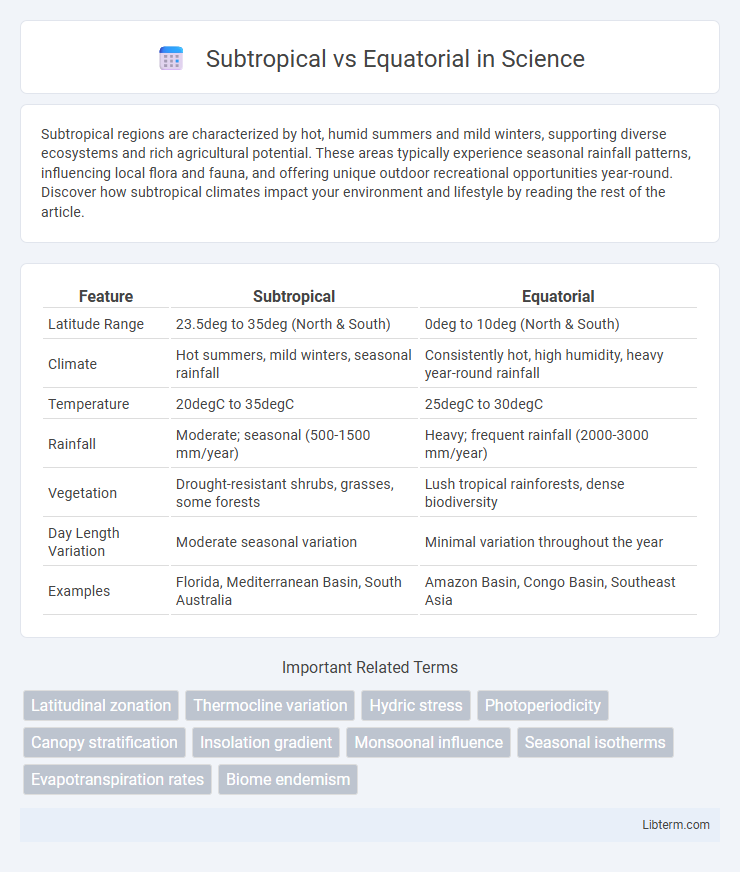Subtropical regions are characterized by hot, humid summers and mild winters, supporting diverse ecosystems and rich agricultural potential. These areas typically experience seasonal rainfall patterns, influencing local flora and fauna, and offering unique outdoor recreational opportunities year-round. Discover how subtropical climates impact your environment and lifestyle by reading the rest of the article.
Table of Comparison
| Feature | Subtropical | Equatorial |
|---|---|---|
| Latitude Range | 23.5deg to 35deg (North & South) | 0deg to 10deg (North & South) |
| Climate | Hot summers, mild winters, seasonal rainfall | Consistently hot, high humidity, heavy year-round rainfall |
| Temperature | 20degC to 35degC | 25degC to 30degC |
| Rainfall | Moderate; seasonal (500-1500 mm/year) | Heavy; frequent rainfall (2000-3000 mm/year) |
| Vegetation | Drought-resistant shrubs, grasses, some forests | Lush tropical rainforests, dense biodiversity |
| Day Length Variation | Moderate seasonal variation | Minimal variation throughout the year |
| Examples | Florida, Mediterranean Basin, South Australia | Amazon Basin, Congo Basin, Southeast Asia |
Introduction to Subtropical and Equatorial Climates
Subtropical climates, typically found between 23.5deg and 35deg latitude, are characterized by hot, humid summers and mild winters with moderate rainfall. Equatorial climates, located near the equator between approximately 0deg and 10deg latitude, exhibit consistently high temperatures and heavy, year-round precipitation due to intense solar radiation and frequent convectional rainfall. These climatic zones influence diverse ecosystems, agricultural practices, and human settlements according to their distinct temperature and humidity patterns.
Geographic Distribution and Location
Subtropical regions are typically located between 23.5deg and 35deg latitude in both hemispheres, encompassing parts of the southern United States, Mediterranean Basin, and northern Australia. Equatorial zones lie near the equator, between 0deg and 10deg latitude, covering areas such as the Amazon Basin, Central Africa, and Southeast Asia. The geographic distribution of subtropical areas features seasonal temperature variations, while equatorial regions maintain consistent high temperatures and humidity year-round.
Key Climate Characteristics
Subtropical climates feature hot, dry summers and mild, wet winters, with temperatures typically ranging from 20degC to 35degC and annual rainfall between 250 to 900 mm, supporting vegetation such as shrubs and drought-resistant trees. Equatorial climates maintain consistently high temperatures around 25degC to 30degC year-round, coupled with abundant rainfall often exceeding 2,000 mm annually, resulting in dense tropical rainforests and high humidity levels. The subtropical region experiences more seasonal temperature variation and distinct wet and dry periods, whereas the equatorial zone is characterized by minimal temperature fluctuations and nearly constant precipitation.
Temperature Patterns and Variations
Subtropical regions experience high temperature variations with hot summers and mild winters, typically ranging from 20degC to 35degC, influenced by their distance from the equator and seasonal shifts. Equatorial zones maintain consistently high temperatures, averaging around 25degC to 30degC throughout the year due to direct solar radiation and minimal seasonal change. Temperature stability in equatorial areas supports dense rainforests, while subtropical climates often feature varied ecosystems adapted to more pronounced temperature fluctuations.
Rainfall and Humidity Differences
Subtropical regions experience moderate to low rainfall with seasonal variability, often marked by dry winters and wetter summers, while equatorial zones have consistently high rainfall distributed almost evenly throughout the year. Humidity levels in equatorial climates remain persistently high, frequently exceeding 80%, due to constant evaporation and dense vegetation, whereas subtropical areas display fluctuating humidity that can drop significantly during dry seasons. These differences result from the subtropical regions' position between 20deg and 40deg latitude with varying pressure systems versus the equator's persistent low-pressure zones driving continuous moisture supply.
Distinct Seasonal Changes
Subtropical regions experience distinct seasonal changes characterized by hot summers and mild winters, often with moderate rainfall variations. Equatorial zones maintain a consistent climate year-round, with minimal temperature fluctuation and frequent rainfall driven by the Intertropical Convergence Zone (ITCZ). These differing patterns influence local biodiversity, agriculture, and human activities, reflecting the climatic divergence between subtropical temperate transitions and equatorial stability.
Flora and Fauna Adaptations
Subtropical regions exhibit flora such as drought-resistant shrubs and evergreen trees adapted to seasonal rainfall and temperature variations, while fauna includes species like reptiles and mammals with adaptations to dry or moderately moist environments. Equatorial zones feature dense, biodiverse rainforests with broadleaf evergreen trees, epiphytes, and lianas thriving in consistently high humidity and temperature, supporting a wide range of animal species adapted to constant moisture and dense canopy cover, such as arboreal primates and diverse insect populations. Both biomes demonstrate specialized adaptations enabling plants and animals to survive in their unique climatic conditions, with subtropical species often coping with periodic drought and equatorial species optimized for year-round wet conditions.
Human Settlements and Lifestyle
Human settlements in subtropical regions often adapt to warm, dry summers and mild winters, fostering agricultural activities like viticulture and olive cultivation, with lifestyles oriented around seasonal water management and outdoor living. Equatorial zones support dense rainforest settlements with high biodiversity, where livelihoods rely on subsistence farming, fishing, and gathering due to consistent high humidity and rainfall. Infrastructure in equatorial areas emphasizes humidity resistance, while subtropical settlements prioritize water conservation and heat mitigation techniques.
Economic Activities and Agriculture
Subtropical regions primarily support diverse agriculture such as citrus fruits, olives, and wine grapes, benefiting from warm, dry summers and mild winters that favor seasonal crop cycles and tourism-driven economies. Equatorial zones, characterized by consistently high temperatures and abundant rainfall, enable year-round cultivation of crops like cocoa, coffee, bananas, and rubber, fueling export-driven agricultural economies and agroforestry industries. Economic activities in subtropical areas often include seasonal farming and manufacturing, while equatorial regions emphasize perennial cash crops and biodiversity-based sectors like timber and ecotourism.
Environmental Challenges and Conservation
Subtropical regions face water scarcity, soil erosion, and frequent droughts, while equatorial zones experience intense rainfall, biodiversity loss due to deforestation, and habitat fragmentation. Conservation efforts in subtropical areas emphasize sustainable water management and combating desertification, whereas equatorial initiatives focus on protecting rainforests and preserving endemic species. Both climates require tailored strategies to address climate change impacts and maintain ecosystem resilience.
Subtropical Infographic

 libterm.com
libterm.com